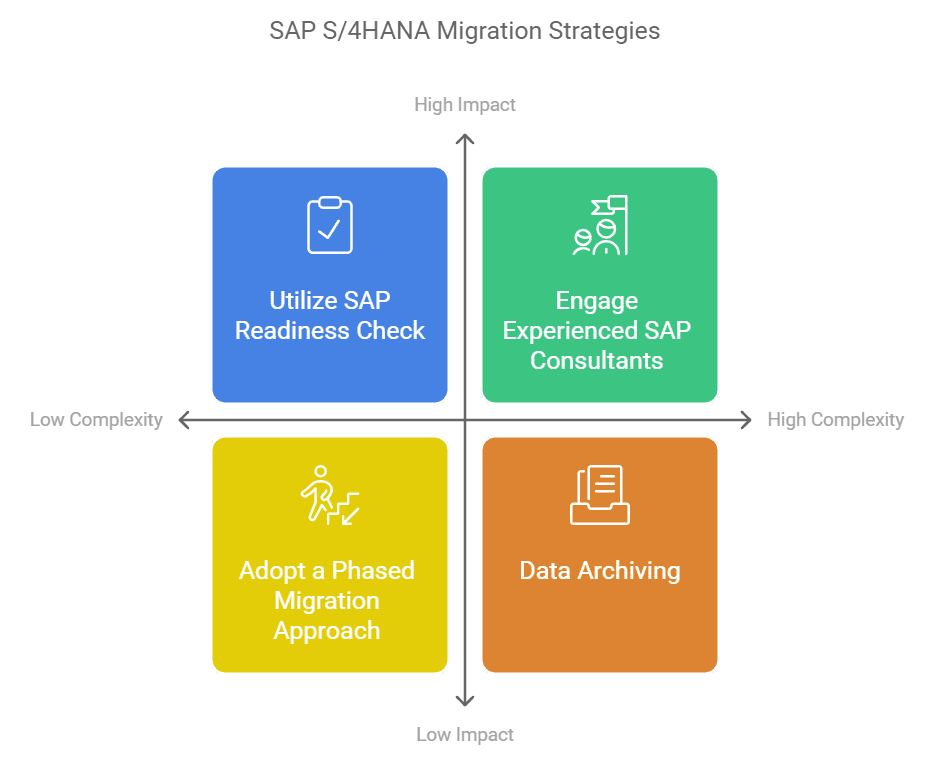Migration Challenges of SAP S/4HANA
Migrating to SAP S/4HANA is a strategic move for businesses looking to enhance efficiency, modernize IT infrastructure, and leverage real-time data analytics. However, despite the potential benefits, the migration process presents several challenges. Understanding these migration challenges of SAP S/4HANA is crucial for a successful transition.
In this blog, we’ll explore the key obstacles companies face when migrating to SAP S/4HANA, along with tips on how to overcome them.
What is SAP S/4HANA?
Before diving into the challenges, it’s essential to understand what SAP S/4HANA is. SAP S/4HANA is an enterprise resource planning (ERP) suite designed to run on the SAP HANA database. It offers advanced features such as real-time data processing, simplified architecture, and better user experience compared to its predecessor, SAP ECC.
Migrating to SAP S/4HANA is more than a technical upgrade—it’s a fundamental shift in business processes, data management, and IT architecture.
Key Migration Challenges of SAP S/4HANA
1. Data Migration Complexity
Data migration is one of the most significant challenges in the transition to SAP S/4HANA. Companies must move historical data from legacy systems to the new platform. This process involves:
- Data cleansing: Removing redundant, obsolete, or irrelevant data
- Data mapping: Ensuring data fields in legacy systems match those in SAP S/4HANA
- Data validation: Ensuring the integrity and accuracy of the migrated data
Failure to manage data migration effectively can lead to data loss, duplication, or inaccuracies, ultimately impacting business operations.
2. Custom Code and Customization Challenges
Many businesses have customized their existing SAP ECC systems to meet their specific needs. Migrating these customizations to SAP S/4HANA is often challenging due to:
- Custom code incompatibility: Some custom codes used in legacy SAP systems may not work on the new platform.
- Rewriting or redeveloping custom code: Businesses must identify which customizations to retain and modify for SAP S/4HANA.
- Impact on system performance: Excessive customizations can hinder performance, defeating the purpose of the migration.
3. Business Process Redesign
SAP S/4HANA comes with modernized business processes, which may differ from the workflows in legacy systems. This requires organizations to re-evaluate and redesign their existing processes:
- Business process standardization: Aligning old processes with SAP S/4HANA’s best practices can be challenging, especially for businesses with complex or highly customized operations.
- Organizational change management: Resistance to change from employees and stakeholders is common, making the redesign process even more difficult.
4. Technical Infrastructure and System Downtime
The infrastructure required for SAP S/4HANA differs from traditional SAP systems. The migration may involve:
- Hardware upgrades: Legacy infrastructure may not support the in-memory database capabilities of SAP HANA.
- Cloud vs on-premises: Companies must decide whether to host SAP S/4HANA in the cloud or on-premises.
- System downtime: Migrating to SAP S/4HANA involves inevitable downtime, which could disrupt business operations if not managed correctly.
5. Cost and Resource Allocation
One of the major migration challenges of SAP S/4HANA is the cost. The migration is an investment that requires:
- Licensing costs: SAP S/4HANA comes with new licensing terms, which could be costly for some businesses.
- Consulting and IT resources: Engaging SAP consultants and IT specialists adds to the overall expenses.
- Internal resource allocation: The migration demands significant involvement from internal teams, impacting regular business activities.
6. User Training and Adoption
User training is a critical step in the migration process. SAP S/4HANA offers a completely new user interface, and many employees may need:
- Extensive training: Users must learn how to navigate the new system effectively.
- Adoption strategies: Encouraging staff to embrace the new system is a challenge, especially for users accustomed to older versions.
7. Compliance and Regulatory Challenges
Data privacy and regulatory requirements differ across industries. Organizations must ensure:
- Compliance with industry regulations: Certain data may need to be handled differently to meet legal standards.
- Data governance: Ensuring that migrated data complies with data protection laws such as GDPR is crucial for avoiding penalties.
Step-by-Step Guide to Overcome Migration Challenges of SAP S/4HANA
| Step | Action Plan |
| Step 1: Planning | Perform a comprehensive assessment of your current system and identify key areas that need upgrading or replacement. |
| Step 2: Data Preparation | Begin data cleansing and ensure that the data to be migrated is accurate, relevant, and compatible with SAP S/4HANA. |
| Step 3: Custom Code Review | Analyze custom code for compatibility and decide whether to retain, modify, or eliminate it for the new system. |
| Step 4: Infrastructure Upgrade | Assess current infrastructure for compatibility with SAP S/4HANA and plan for necessary hardware or cloud solutions. |
| Step 5: Process Redesign | Align current business processes with SAP S/4HANA’s modern workflows and engage stakeholders for support. |
| Step 6: User Training | Develop a comprehensive training program to ensure all users can transition smoothly to the new system. |
| Step 7: Testing and Validation | Conduct end-to-end testing to ensure that data, processes, and systems work as expected. |
| Step 8: Go-Live and Post-Migration Support | Plan for downtime, execute migration, and offer ongoing support to resolve any post-migration issues. |
Additional Strategies to Mitigate Migration Challenges of SAP S/4HANA

- Utilize SAP Readiness Check: This tool helps assess system readiness by identifying compatibility issues, custom code requirements, and potential risks.
- Engage Experienced SAP Consultants: External expertise can help businesses navigate the complexities of migration and provide best-practice recommendations.
- Adopt a Phased Migration Approach: Instead of performing a full-scale migration at once, organizations can opt for a phased approach, allowing time for testing and troubleshooting before going live.
- Data Archiving: Archive old and unused data to reduce the volume and complexity of the migration process.
Common Mistakes to Avoid in SAP S/4HANA Migration
- Underestimating the complexity of data migration: Incomplete or inaccurate data can disrupt business operations post-migration.
- Neglecting user training: Insufficient user training can result in poor adoption rates and productivity loss.
- Lack of a solid migration strategy: A vague or incomplete strategy can lead to cost overruns, missed deadlines, and system downtimes.
- Skipping comprehensive testing: Not thoroughly testing the new system can result in performance issues or errors after going live.
- Failing to account for compliance: Overlooking regulatory requirements can lead to legal complications, fines, or data breaches.
Conclusion
Migrating to SAP S/4HANA is a crucial step for businesses aiming to modernize their ERP systems and enhance operational efficiency. However, the migration challenges of SAP S/4HANA, such as data migration complexity, custom code compatibility, process redesign, and high costs, must be addressed thoughtfully.
By understanding these challenges and following a well-structured approach, businesses can minimize risks, reduce downtime, and ensure a smooth transition to SAP S/4HANA. Investing in the right resources, including expert consultants and robust training programs, will further ensure that the migration delivers the intended benefits.

